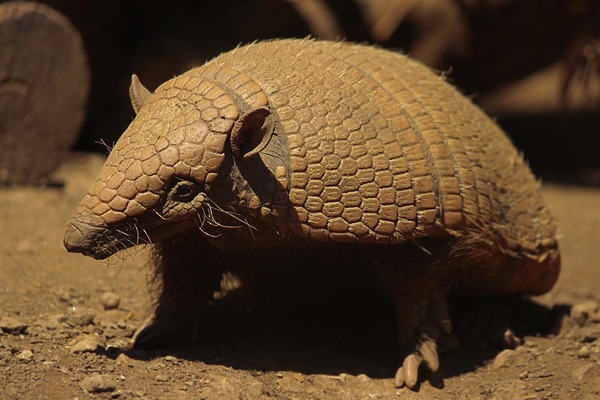Leprosy, also known as Hansen's disease, is a chronic infectious disease caused by the bacteria Mycobacterium leprae. While leprosy is often thought of as a strictly human disease, it may surprise you to learn that certain animals are also carriers of the bacteria that cause this condition. In fact, humans can contract leprosy through contact with these animals, raising questions about the disease’s spread in both human and animal populations.
In this article, we'll explore the primary animal species associated with leprosy transmission, the role they play in spreading the disease, and the preventive measures humans can take.
Nine-banded armadillos (Dasypus novemcinctus) are the most well-known animal species linked to leprosy. These small mammals, found in North, Central, and South America, have a unique connection to the disease. Scientists have discovered that armadillos can harbor Mycobacterium leprae, and they are one of the few non-human species known to naturally contract and carry the bacteria.

While the exact mechanism is not fully understood, it's believed that people can become infected with leprosy by handling armadillos or coming into contact with their bodily fluids. This is more common in regions where human and armadillo populations overlap, particularly in the southern United States, such as Texas and Louisiana.
Interestingly, armadillos' body temperature is lower than that of most mammals, which makes them a favorable host for the M. leprae bacteria. Their cool body temperature allows the bacteria to survive and multiply more effectively, increasing the likelihood of transmission.
In recent years, research has shown that armadillos and humans in certain areas share the same strain of leprosy-causing bacteria. A 2011 study published in the New England Journal of Medicine found that about one-third of recent leprosy cases in the southern U.S. could be linked to contact with armadillos. Genetic analysis of the bacteria found in both humans and armadillos confirmed that they shared the same strain, establishing a direct connection between the two.
While armadillos are the most well-known leprosy carriers, they are not the only animals capable of harboring Mycobacterium leprae. Other animals can play a role in spreading this bacterium, although cases are rarer and less understood.
In some areas, non-human primates have been found to carry Mycobacterium leprae. For example, a 2020 study published in the journal Science reported leprosy infections in wild chimpanzees in West Africa. This discovery suggests that leprosy may circulate more widely in animal populations than previously thought, though the exact transmission pathways from animals to humans in these cases are still being investigated.
There has been evidence of leprosy-causing bacteria in red squirrels (Sciurus vulgaris) in the United Kingdom. Some populations of red squirrels have been found to carry both Mycobacterium leprae and another closely related bacterium, Mycobacterium lepromatosis, which also causes a form of leprosy. While the risk of transmission from squirrels to humans is extremely low, it highlights the possibility that the bacteria may be present in various wild animal species.

While leprosy is rare, and the chances of contracting it from animals are low, it’s still important to take precautions if you live in an area where animal carriers like armadillos are common.
Avoid direct contact with armadillos: If you live in regions where armadillos are present, avoid handling them or coming into close contact with them. If you must handle an armadillo (for research or wildlife management purposes), always wear gloves.
Practice good hygiene: Wash your hands thoroughly after being outdoors, especially if you’ve been in areas where animals might have been present.
Stay informed: Be aware of leprosy outbreaks or cases in your region, particularly if they are linked to wildlife.
Seek medical attention: If you suspect that you have been exposed to leprosy, especially if you’ve had contact with an armadillo or other wildlife, consult a healthcare professional immediately. Early diagnosis and treatment are critical to managing the disease.
While Mycobacterium leprae is primarily a human pathogen, certain animals—particularly armadillos—can also harbor and spread the bacteria responsible for leprosy. The link between armadillos and human leprosy cases has been well-documented, particularly in the southern United States. Other animals, such as non-human primates and red squirrels, have also been found to carry the bacteria, though the risk of transmission from these species is much lower.
Understanding the connection between animals and leprosy is vital for controlling the spread of the disease, especially in areas where humans and wildlife coexist closely. By taking precautions and staying informed, you can reduce the risk of contracting this rare but serious disease.
Q: Can you get leprosy from touching an armadillo?
A: Yes, it is possible to contract leprosy through direct contact with armadillos or their bodily fluids, although the risk is low.
Q: Are armadillos the only animals that can carry leprosy?
A: No, other animals like chimpanzees and red squirrels have also been found to carry the leprosy bacteria, but armadillos are the primary known animal carriers in the Americas.
Q: Is leprosy still common today?
A: Leprosy is now rare and treatable with antibiotics. However, it still exists in some parts of the world, including the United States, where armadillos are a known source of infection.
animal tags: Leprosy
We created this article in conjunction with AI technology, then made sure it was fact-checked and edited by a Animals Top editor.